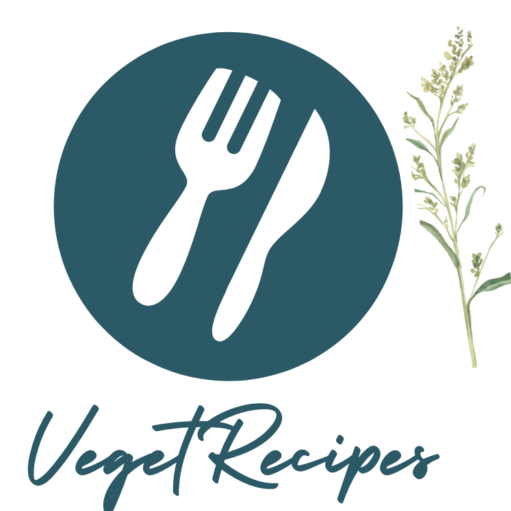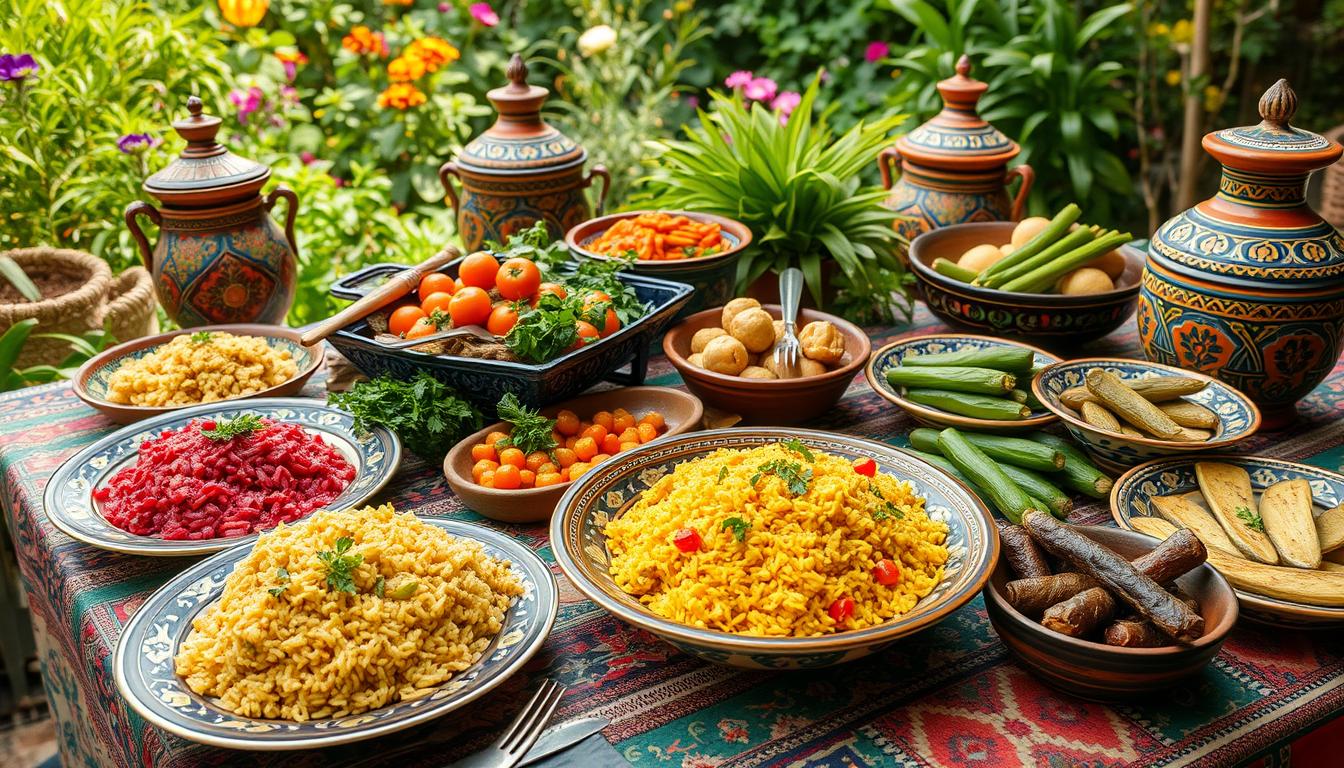Did you know that all recipes from Plant-Based Persian are vegetarian or vegan? This shows a big focus on plant-based food in Persian cooking. It’s great news for those looking for healthy, tasty meals.
In this article, we’ll explore Persian Vegetarian Recipes. We’ll use old cooking traditions to share healthy, flavorful dishes. You’ll find everything from hearty stews to fresh herb rice. These recipes are not just good for you, but also delicious.
Whether you’re a vegetarian, a meat-lover, or just love trying new foods, Persian vegetarian recipes are for you. They mix aromatic spices, fresh herbs, and whole grains. Join us as we discover these healthy, plant-based dishes from Iran.
Key Takeaways
- 100% of the recipes shared are vegetarian or vegan, showing a big focus on plant-based dishes in Persian cuisine.
- Soups make up 40% of the recipes, showing their popularity and variety in Middle Eastern vegetarian cooking.
- Beans are in 30% of the dishes, highlighting their importance in healthy Persian recipes.
- Aubergines/eggplants are in 20% of the recipes, showing their key role in Persian cooking.
- Try a variety of nutritious, plant-based ingredients like fresh herbs, beans, and grains for healthy dinners.
Introduction to Persian Vegetarian Recipes
Persian cuisine is famous for its long history and wide range of flavors, with a big focus on vegetarian dishes. Dishes like “Adas Polo,” a rice dish with lentils, raisins, and dates, are very nourishing. They show the long history of Persian cooking, using fresh herbs, fruits, and vegetables from the Middle East.
The Rich History of Persian Vegetarian Recipes
Persian vegetarian recipes have a history of over three thousand years. Old texts like cuneiform clay tablets talk about these cooking methods. They show how Persian cooking uses nuts, fruits, and souring agents like pomegranate molasses.
This rich history has also influenced the cooking of nearby countries like Afghanistan, Turkey, and Armenia.
“Persian cookery incorporates balancing contrasting qualities in its dishes, such as hot and cold, sweet and tangy, and heavy and light, making it uniquely versatile.”
When Cyrus the Great conquered many lands, he spread Persian food culture far and wide. This tradition of “sofreh,” or setting the table for a meal, has lasted through the ages and is seen in Iranian homes today.
Why Choose Persian Vegetarian Recipes?
Choosing authentic Iranian plant-based dishes is great for health and the environment. Dishes like “Kookoo Kadoo,” a courgette frittata, and “Morgh-e Torsh,” a herb-infused stew, show the hearty and flavorful side of veggie Persian cuisine.
- Nutritious and Healing: Ancient Iranian scientists studied healthy cooking, making recipes that are good for you and help heal.
- Sustainable and Diverse: Iran’s varied climate means recipes use many local products, supporting biodiversity and sustainable farming.
- Culinary Exploration: Persian vegetarian recipes offer unique flavors with herbs and spices, making for a rich and satisfying meal.
Trying Persian vegetarian recipes is good for your health and honors a rich cultural tradition. These dishes are delicious and full of history.
To start exploring Persian vegetarian recipes, here’s a look at some classic dishes and their ingredients.
| Dish Name | Main Ingredients | Description |
|---|---|---|
| Adas Polo | Lentils, raisins, dates | A wholesome rice dish enhanced with the natural sweetness of fruits. |
| Morgh-e Torsh | Herbs, pomegranate molasses, walnuts | Herb-infused vegetarian stew with a unique tangy flavor. |
| Kookoo Kadoo | Courgette, eggs | A versatile courgette frittata served as a main course or snack. |
| Sabzi Polo Semnani | Rice, black-eyed peas, fresh herbs | A fragrant rice dish from Semnan province, combining fresh local herbs. |
Benefits of Persian Vegetarian Recipes
Persian vegetarian recipes are full of benefits. They add flavor and nutrients to your diet and help the environment. Each dish is a mix of herbs and spices, making them tasty and healthy.
Health Benefits of Persian Vegetarian Recipes
These recipes are packed with nutrients. Lentils, a key ingredient, are high in fiber. This helps your gut and keeps you full longer. They also have vitamins B, iron, magnesium, zinc, and potassium, which fight fatigue and boost energy.
Lentils also have antioxidants and anti-inflammatory properties. They help prevent diabetes, heart disease, and some cancers. This makes them a great choice for a healthier diet.
A Sustainable and Flavorful Option
Persian vegetarian recipes are good for the planet. They often use legumes like lentils, which need less water and produce fewer greenhouse gases. These meals are rich in plant-based proteins, which is good for the environment.
Herbs and spices, like turmeric and black pepper, add flavor and health benefits. This mix of sustainability and taste makes Iranian Herb-Based Meals appealing.
Persian Vegetarian Recipes: A Unique Culinary Experience
Persian vegetarian cuisine offers a special culinary journey. From Ash-e Anar, a pomegranate soup, to herb-rich stews and rice pilafs, there’s a lot to explore. The use of diverse vegetables adds vitamins and variety to your meals.
These recipes honor tradition while fitting modern dietary needs. They make any meal plan more enjoyable and satisfying.
Essential Ingredients for Persian Vegetarian Recipes
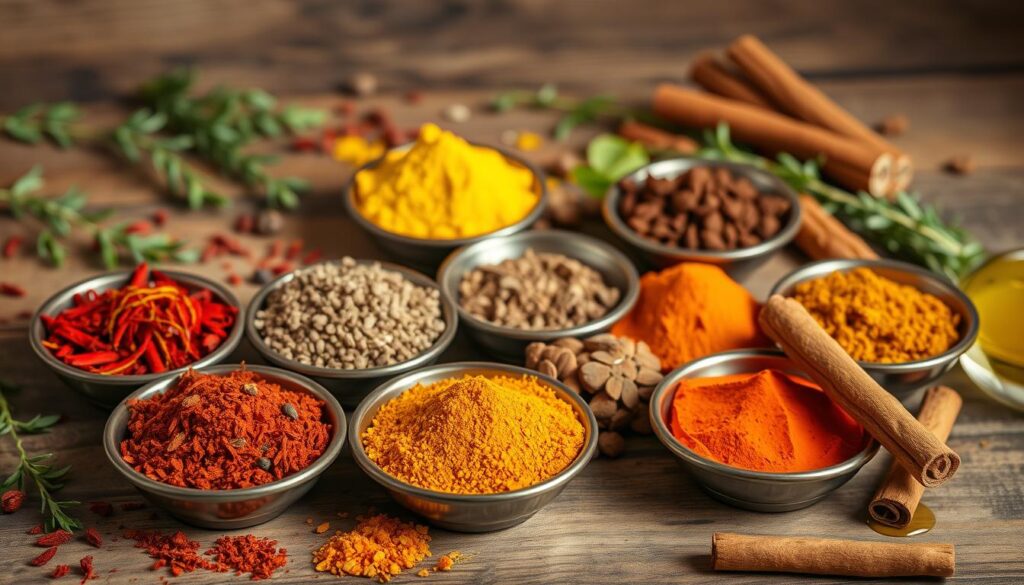
Choosing the right ingredients is key to making authentic Persian vegetarian dishes. Traditional Persian Ingredients, Middle Eastern Spices, and Vegetarian Cooking Staples are essential. They help create memorable meals. Let’s look at important herbs, spices, vegetables, and staples for Persian vegetarian recipes.
Unique Herbs and Spices in Persian Vegetarian Recipes
Persian cuisine is known for its aromatic spice blends. Spices like saffron, turmeric, and fenugreek add depth and color. Fenugreek, or shambalileh, is vital in Ghormeh Sabzi, giving it a unique taste.
Limoo amani, or dried limes, add a tangy flavor to Persian dishes. This is often seen in vegetarian versions.
Fresh Vegetables Commonly Used in Persian Vegetarian Recipes
Fresh vegetables are a must in Persian vegetarian dishes. Eggplants, spinach, and tomatoes are often used. They’re seasoned with a mix of Persian Ingredients.
In vegetarian Ghormeh Sabzi, mushrooms replace meat. They add texture and umami flavor. The mix of fresh ingredients and spices makes simple vegetables special.
Staples Like Rice, Lentils, and Grains
Basmati rice, lentils, and grains are the foundation of many Persian vegetarian recipes. Basmati rice is served with stews, often with a crispy tahdig layer. Red kidney beans add protein and texture, while lentils provide a nutritious base.
These ingredients are easy to find and versatile. They’re perfect for making a variety of Persian-inspired meals.
| Ingredient | Purpose | Common Dish |
|---|---|---|
| Fenugreek | Flavor and aroma | Ghormeh Sabzi |
| Dried Limes (Limoo Amani) | Tangy flavor | Stews and rice dishes |
| Basmati Rice | Textural base | Persian Rice (Tahdig) |
| Mushrooms (Cremini) | Meat substitute | Vegetarian Ghormeh Sabzi |
| Red Kidney Beans | Protein and texture | Stews |
Step-by-Step Persian Vegetarian Recipes
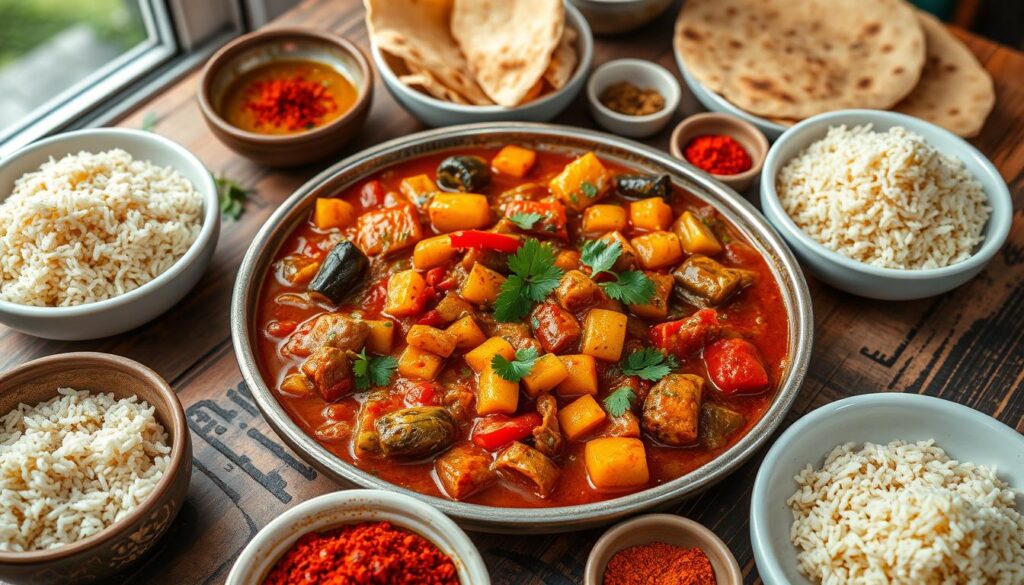
Exploring Persian cuisine is a flavorful journey. Here’s a guide to mastering Persian Stew Recipes and making delicious pies. Cooking Persian dishes is an adventure. Follow these steps to create amazing meals every time.
Preparing Ingredients for Persian Vegetarian Recipes
Preparation is key in cooking Persian dishes. Start by gathering fresh herbs like spinach, parsley, and coriander. Legumes like chickpeas and lentils are also important.
For Ash-e Reshteh, soak dried legumes for 2 to 12 hours. For Adas Polo, use Basmati rice, sautéed raisins, and ground cinnamon. These ingredients add to the dish’s flavor.
Crafting the Perfect Persian Stew
Making the perfect Persian stew requires attention to flavors and textures. Use fresh herbs and spices like saffron to enhance the dish. Here’s a breakdown of a classic Persian stew:
Ash-e Reshteh is a famous Persian stew with many herbs and beans. It takes 1 hour to prepare and 2 hours to cook. Start by sautéing onions and garlic, then add soaked beans, lentils, and herbs. Add Persian noodles and optional beef bone for richness.
Serve it with Kashk or vinegar for a personal touch. This stew’s aroma and flavor are perfect for family gatherings.
Baking Persian-Inspired Vegetarian Pies
Persian Vegetarian Pies add joy to any meal. They combine fresh vegetables, legumes, and spices in flaky pastry. Focus on these steps when making Persian pies:
- Filling: Mix cooked lentils, spinach, and onions with spices like cinnamon and saffron.
- Pastry: Use olive oil dough for a flaky texture.
- Assembly: Place the filling in the dough, fold, and seal. Bake until golden.
These pies are satisfying and delicious. They serve 8 to 10 people, perfect for sharing. The mix of herbs, spices, and vegetables captures Persian cuisine’s essence.
| Recipe Name | Preparation Time | Cooking Time | Servings |
|---|---|---|---|
| Ash-e Reshteh | 1 hour (plus soaking time for legumes) | 2 hours | 8-10 |
| Adas Polo | 20 minutes | 40 minutes | 6-8 |
| Vegan Abgoosht | 20 minutes | 1.5 to 2 hours | 2 |
Delicious Variations of Persian Vegetarian Recipes
Exploring Persian vegan dishes opens a world of flavors. From herb-infused rice to savory stews and kebabs, there’s much to discover. Let’s dive into some standout recipes that bring Persian cuisine to your table.
Herb Rice with Beans
Herb rice with beans, or “Nokhod Polo,” is a classic. It mixes aromatic herbs with tender beans. Fresh herbs like dill, parsley, and cilantro are blended with basmati rice. Serve it with pickled vegetables for a complete meal.
Eggplant and Tomato Stew
The eggplant and tomato stew, or “Mirza Ghasemi,” is comforting. It roasts eggplants until golden and then simmers them with onions, garlic, tomatoes, and chickpeas. Here’s a quick overview of the ingredients and cooking process:
| Ingredients (4 servings) | Amount |
|---|---|
| Italian eggplants | 2 large |
| Canned chickpeas | 3 cups |
| Tomatoes | 2 medium |
| Onion | 1 medium |
| Garlic cloves | 3 |
| Water | 700 ml |
| Bottled tomato passata | 400 grams |
| Tomato paste | 3 tablespoons |
| Extra virgin olive oil | 2 tablespoons |
Roast the eggplants for 15-20 minutes, then simmer the stew for 30-45 minutes. Add a pinch of ground saffron to boiling water for extra flavor. Serve with Persian rice, crunchy Tahdig, and a fresh Shirazi Salad for a complete meal.
Persian-Inspired Vegetarian Kebabs
Persian veggie kebabs are a delightful addition to any meal. They’re made with seasoned vegetables like bell peppers, mushrooms, and onions. Grilled to perfection, serve them with saffron rice and creamy mast-o-khiar for a complete experience.
Whether it’s herb rice or a flavorful tomato stew, Persian vegan dishes are sure to delight. They offer a unique culinary experience that will captivate your taste buds.
Serving Persian Vegetarian Recipes
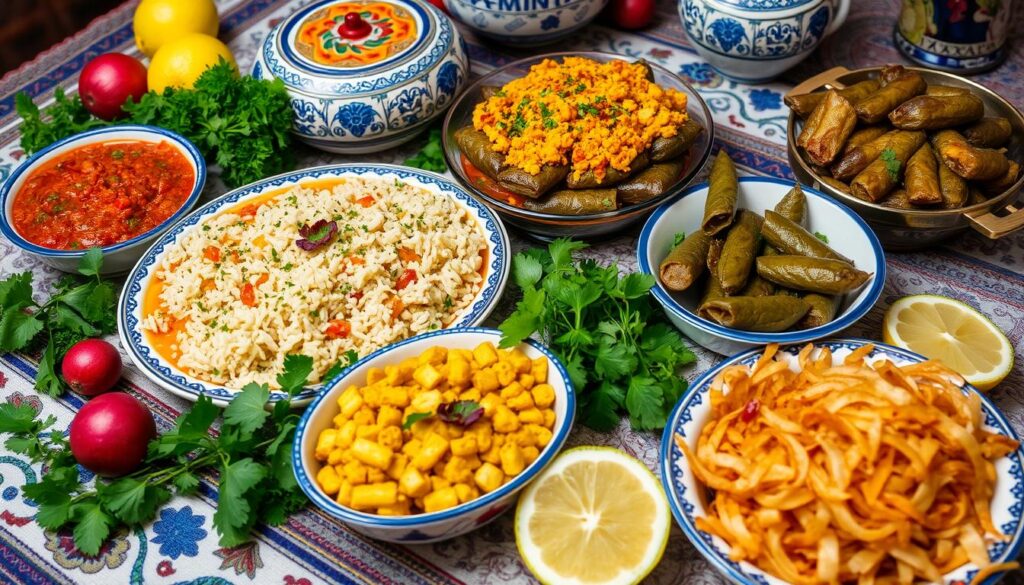
Adding the right touches to your Persian vegetarian meals makes them special. Let’s look at the best side dishes, sauces, dips, and drinks for a full and tasty meal.
Side Dishes to Pair with Persian Vegetarian Meals
Persian food is known for its amazing flavors. Try Shirazi salad, with cucumbers, tomatoes, onions, and lime juice. It’s a hit. Mast-o-Khiar, a yogurt and cucumber dip with mint, also pairs well with main dishes.
These side dishes are key to making your meals better. They balance and enhance the flavors of the main dishes. Adding them to your meals showcases Persian cooking’s beauty.
Sauces and Dips for Persian Vegetarian Recipes
Persian sauces are essential in many dishes, adding unique tastes. Kashk, a fermented dairy product, is great in appetizers and soups. It adds a savory and creamy element. Ghormeh Sabzi, a herb sauce, makes vegetarian stews richer and more flavorful.
Ideal Beverages to Complement Persian Vegetarian Recipes
No Persian meal is complete without the right drink. Doogh, a yogurt-based drink, is refreshing and tangy. It pairs well with the spices in these dishes. Its bubbly nature cleanses your palate, making each bite a delight.
These Persian vegetarian drinks, along with the right side dishes and sauces, make for a balanced and enjoyable meal. Dive into the rich and flavorful world of Persian vegetarian cuisine!
Tips for Perfect Persian Vegetarian Recipes
To make perfect Persian vegetarian recipes, you need to know about Persian spices, how to present them, and cooking techniques. Here are some key tips for cooking Persian dishes that will make your meals special.
Balancing Spices in Persian Vegetarian Recipes
Using Persian spices is all about finding the right mix. Saffron adds a luxurious taste and smell. Mix it with a bit of cinnamon for warmth. The goal is to make sure no spice is too strong, so all flavors work together well.
Creative Presentation Ideas
How you present your vegetarian meals is important. Adding pomegranate seeds and fresh herbs not only looks good but also tastes great. Serving dishes like Ab Doogh Khiar or Mirza Ghasemi in nice bowls makes the meal even better. Here’s a look at a beautifully set Persian vegetarian dish.
Tips for Cooking Persian Vegetarian Stews
Getting the cooking time and method right for Persian stews is key. Slow cooking is best to blend the flavors, which is great for hearty dishes in cold weather. Adding ingredients at the right time keeps the texture and taste right, making your stews both healthy and tasty.
| Dish | Main Ingredients | Cooking Time | Best Season |
|---|---|---|---|
| Ash Anar | Pomegranate, Herbs | 2 hours | Autumn, Winter |
| Baghala Ghatogh | Fava Beans, Dill, Eggs | 1 hour | All year |
| Gojeh Bademjaan | Eggplant, Tomatoes, Spices | 45 minutes | All year |
Storing and Reheating Persian Vegetarian Recipes
Keeping your Persian vegetarian meals fresh and flavorful is key. This section offers food storage tips and reheating meals advice. You’ll learn how to keep your dishes tasting great.
How to Store Persian Vegetarian Leftovers
Leftovers from Persian vegetarian dishes like Ash Reshteh are a treat. Store them in airtight containers to keep moisture and flavor in. Ash Reshteh, with its protein, fiber, and vitamins, stays nutritious when stored right.
You can refrigerate these meals for up to 4 days. Freezing them keeps them fresh for about 2 months. This way, the flavors and nutrients stay maintained.
Reheating Persian Vegetarian Recipes Without Losing Flavor
Reheating meals right is all about keeping flavor and texture. For Ash Reshteh, use the stovetop or microwave. Stovetop reheating is best, as it lets you stir and avoid hot spots.
This method keeps the soup’s tangy flavor from Kashk. If microwaving, use medium power and stir often to heat evenly.
By following these food storage tips and reheating methods, you’ll enjoy every bite. Your Persian vegetarian meals will taste like they’re freshly made.
Conclusion: Mastering the Art of Persian Recipes
Starting our journey in Persian cooking has been incredibly rewarding. We’ve explored the deep history of Persian vegetarian dishes. This ancient cuisine, dating back over 3,000 years, is loved by many today.
Persian food is known for its unique spices like saffron, cinnamon, and cardamom. These spices show the creativity and resourcefulness of the Achaemenid Empire.
Learning Persian vegetarian cooking opens up a world of healthy meals. It focuses on fresh herbs, nuts, dairy, and traditional cooking methods. These methods highlight the natural flavors of ingredients.
The sofreh, or family-style serving, adds to the sense of community in Persian meals. Ingredients like dried limes, pomegranate molasses, and rosewater make each dish special. The right balance of spices and souring agents create unforgettable flavors.
To keep Persian cooking alive, we must keep trying new ingredients and techniques. Using traditional tools like mortars and pestles adds authenticity to our cooking. Exploring these recipes not only improves our health but also honors a long-standing cultural tradition.
Let’s make Persian vegetarian recipes a key part of our cooking. This way, every meal can be both tasty and healthy.
